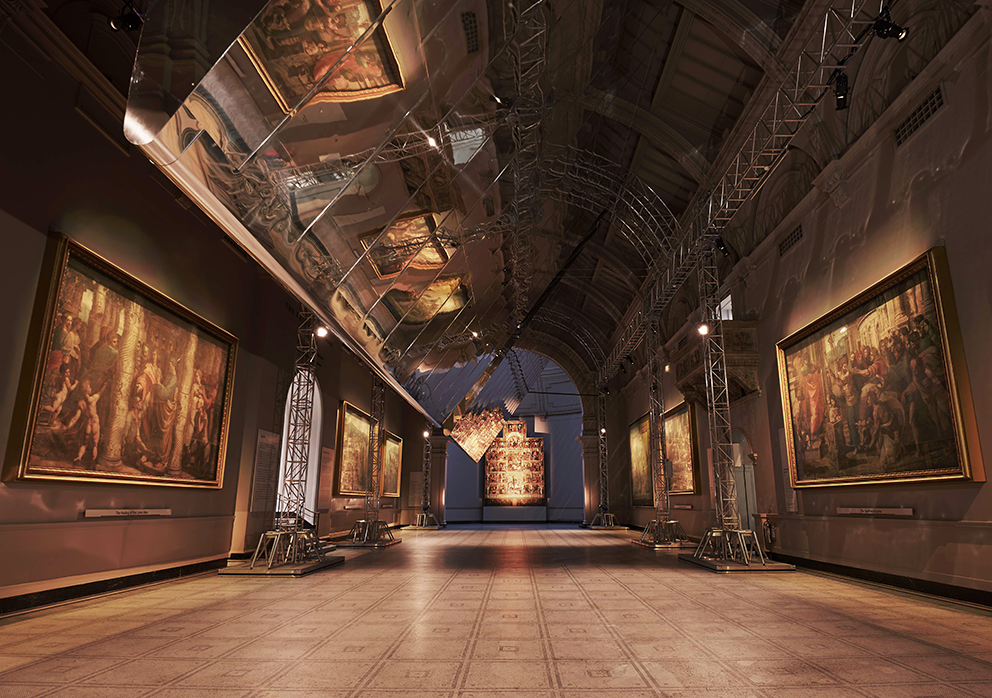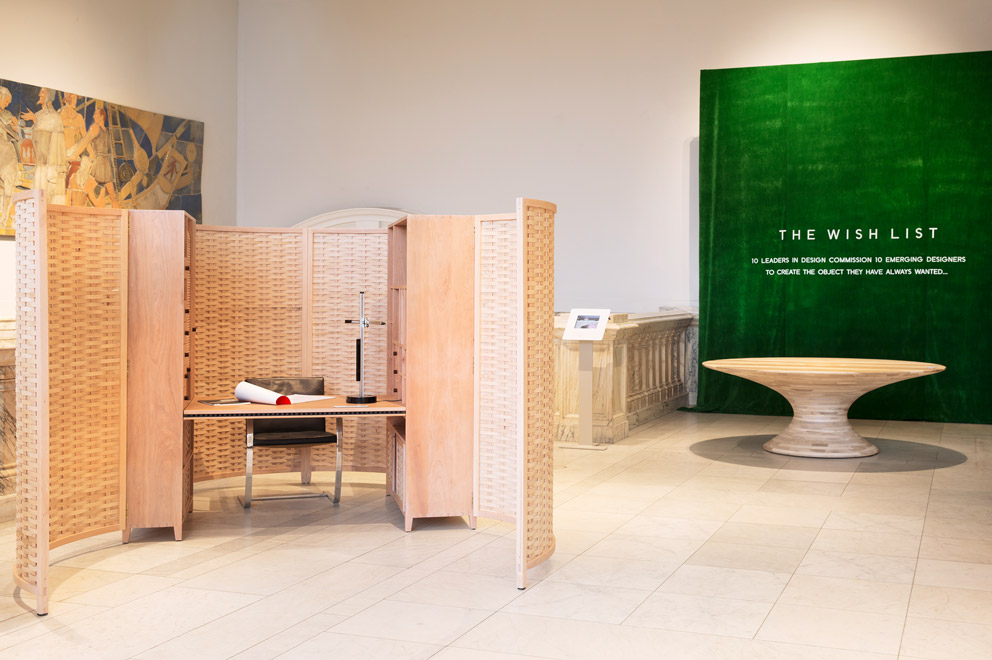
Design duo Barber & Osgerby suspended two rotating reflective wings from the massive ceiling of the V&A’s Raphael Cartoon gallery, called “Double Space for BMW”. Photo © London Design Festival
Mirror, mirror on the wall
|
|
by Antje Southern
Sep 26, 2014 Subtly omnipresent in this year’s London Design Festival (LDF), mirrors reflect, fragment or distort the viewer’s perception of space. Design duo Barber Osgerby suspended two rotating reflective wings from the massive ceiling of the V&A’s Raphael Cartoon gallery. This mighty display of German precision engineering aptly named “Double Space for BMW” creates a mesmerizing and disorientating experience. For a fleeting moment the visitor becomes part of the gallery space. Through movement and reflections, the static world of the Raphael Cartoons is brought to life while viewers and the gallery are invited to be part of the performance. This ambitious kinetic installation and the multifaceted and fragmented viewing experience it offers are typical of the festival itself: The way that design talents, ideas and products are presented throughout the city feels compelling. Truer than ordinary glass Mirrors were the key devices with which John Soane, the groundbreaking 19th architect, embellished the limited footprint of his Georgian townhouse. His mastery of infusing the dark English interior with a sense of light and space has inspired a selection of contemporary pieces including Mineheart’s Edison “Pendant Lamp”, Sebastian Bergne’s “Flame Lamp” and Ab Roger’s and Min San Cho’s “Love is still alive” kinetic light. “Mirror 6” designed by Tiipoi is ideally aligned to reflect the surroundings and one of the most intriguing pieces on show in the Breakfast Room at the John Soane Museum. Making most the of the festival’s diverse locations, Tiipoi simultaneously launched its metal serving ware collection at Designjunction, the venue that occupies the entire floor space of the empty sorting office opposite the British Museum. The future of travel At the entrance level at the Designjunction, car marque Mini presents “Mini: Frontiers” and has commissioned six young creative talents to come up with a vision for the mobility of the future. Taking their inspiration from the new Mini Hatch, the designers were asked to explore how design and new technologies can help transform the world of travel. Pernila Ohrstedt’s research into virtual travel through 3D mapped cities has resulted in a digital reproduction of the exhibition space at Designjunction. To personalize the driving experience, Matthew Plummer-Fernandez imagines a smart dashboard figurine connected to the car’s GPS and offering tips to the driver in line with personal driving preferences and speed. What could be possible if the car becomes a digital scanning device and safety is guaranteed? Inventor, Dominic Wilcox came up with the world’s first stained glass window automobile with a bed inside. Inspired by the windows of Durham Cathedral, Wilcox’ car as an entirely responsive vehicle that doubles up as an individual artwork. It is intriguing to think that the re-appreciation of craft skills is facilitated through advances in digital technologies or synthetic biology, as with Daisy Ginsberg’s most impressive and far-reaching proposal. At the Royal College of Art workshop Ginsberg has been making 112 miniature cars to create a “model ecosystem” of vehicles to investigate how cars could behave like living organisms. If manufacturers were able to use natural or genetically modified materials in car design, cars of the future could mutate in response to local climates, materials, and skills. The alchemy of materials While whizz-kid programmers play out the possibilities of digital technology at the specially curated “Tokyo Imagine” at show Tent London, it appears that a quest for sustainability is at the heart of an emerging design generation. Akin to medieval alchemists, graduates from Central St Martin’s “Material Futures” degree course investigate the properties of materials and the processes inherent to them. CSM graduate Ella Bulley, for example, experiments with sugarcane and bio resins to produce biodegradable tiles and bowls that can be press-molded like clay and carved like stone. Showing with “Cargo Collective”, a group of other graduates at Designersblock, her project is part of a larger body of student work tackling new approaches. Similar examples are omnipresent in locations as disparate as “100% Design” trade fair at Earls Court or the posh design galleries such as Mint and Aram. How established designers make use of the special properties of materials and production techniques is theme of a small exhibition “Austurland: Designs from Nowhere” in a pop-up space in a South Kensington mews by Spark Design Space, a gallery from Reykjavik. Each designer went through an intensive learning process to appropriate the potential of the materials. Þórunn Árnadóttir’s “Skip Ahoy” collection of skipping ropes, hula-hoop rings and tote bags resulted from a collaboration with a net-making factory in Eskifjörður; Julia Lohman’s experiments with the translucency and suppleness of seaweed for use in design and manufacture in lampshades and vessels. A machine that builds itself “Candela” is a project that exemplifies how the V&A as the festival’s design hub actively facilitates and furthers interdisciplinary research. The designers describe their undertaking as a machine that “built itself” through the interplay of material properties and manufacturing potential during the development stages. Tapping their individual skill sets, product designer Felix de Pass, graphic designer Michael Montgomery and ceramicist Ian McIntyre engineered a rotary machine, its circular movement alluding to the watches made by the sponsor Officine Panerai. The flat surface resembling a clock face is made of a photo-luminescent material that is charged with bursts of light from a sequenced LED and fades into an afterglow as it turns. Set in the darkness of the V&A tapestry room, “Candela” creates soft gestural light, a surprisingly low-tech effect attained through high-tech materials.The persuasive focus on materials seems to have brought about a passion for skilled craftsmanship at the LDF. Jeremy Maxwell Wintrebert fell in love with the unique mouth blown glass cylinders made by Lamberts Glass in Waldsassen, Germany and commissioned by the V&A and in collaboration with Perrier-Jouët created an ambitious site-specific installation of colored glass cylinders . What I have always wanted The “Wish List” also hosted at the V&A was organized in conjunction with LDF and the American Hardwood Export Council who challenged designers to produce each project in American hardwood. 10 design legends chose 10 emerging talents who were asked to design something for their mentors that the latter had always wanted. The design teams developed their ideas together and the pieces were crafted and produced at the Benchmark studio and factory in Kintbury, West Berkshire. Norman Foster wanted a pencil sharpener made in the least expensive wood, while Terence Conran wanted a private workplace - Sebastian Cox built him a curved screen woven out of red oak that was soaked in the river running through the grounds of Terence Conran’s country house. This local connection is an important element in the work of Sebastian Cox, who cracks fresh cobs on his stand at Tent London. Cox takes his axe to the Kentish woodlands and works with the timber he felled, for example creating table legs from branches left intact with bark. A renewed interest in the properties of materials is transforming creative processes as can be seen in the innovative “Drop Umbrella” and other graduate pieces on display. Interdisciplinary exchanges between science and design make it possible to develop amazing projects such as “Candela” and Dezeen and MINI: Frontiers that explore the future of mobility. Barber & Osgerby’s “Double Space for BMW” demonstrates how an equivalent relationship between a brand and a designer allows an object to evolve in order to respond to and transform its environment with integrity. The “Wish List” shows that it is possible for successful new products to materialize in wood through alliances of emerging and established designers supported by suppliers and manufacturers. This year’s LDF spotlights the need for teamwork more than ever and highlights how collaborative dialogue that respectfully explores traditional methodologies and advanced technologies with curiosity can open up new design strategies for the future.
|

Lighting installation by Daniel Libeskind at the “100% Design”-exhibition Earls Court entrance. Photo © 100% Design

“100% Design” entrance created by Studio Design UK. Photo © 100% Design

Maker spaces at “100% Design” are promoting an informed hands-on process and material-led knowledge. Photo © 100% Design

A chair to go. Photo © 100% Design

Dominic Wilcox presents his driverless car with bed inside and made of handmade glass inspired by Tiffany Lamps at the “Mini Frontiers” project. Photo © Antje Southern

“Tokyo Imagine” at Tent: Festoon Island using ikebana japanes flower art. Photo © Antje Southern

Central St Martin’s “Material Futures”: graduate Ella Bulley experiments with sugarcane and bio resins to produce biodegradable tiles and bowls. Photo © Antje Southern

“Austurland: Designs from Nowhere” at a South Kensington Mews shows the “Skip Ahoy” collection by Þórunn Árnadóttir from Reykjavik. Photo © Antje Southern

“Pernilla” wooden shoes by Cat Potter, who uses 3D techniques for it, at Aram Gallery. Photo © Antje Southern

Jeremy Maxwell Wintrebert cooperated for this installation of mouth blown glass cylinders with German company Lamberts Glass, on show at the V&A. Photo © London Design Festival
|



Felix de Pass, Michael Montgomery and Ian McIntyre engineered a rotary machine, its circular movement alluding to the watches made by the sponsor Officine Panerai. Photo © London Design Festival
|

“Military Sectret” by James Rigler. Photo © London Design Festival
|
